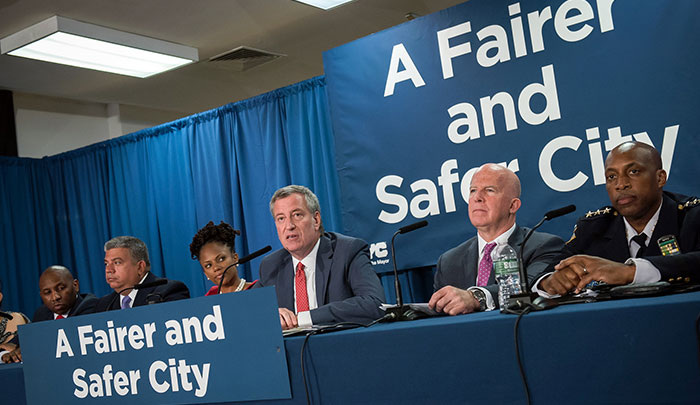Photo Courtesy of Ed Reed/Mayoral Photography Office
“This new policy will help reduce unnecessary arrests, while making our city fairer and safer,” Mayor de Blasio said on Tuesday.
By Michael V. Cusenza
By Sept. 1, the majority of New Yorkers found smoking marijuana in public will face criminal summonses instead of arrest, according to Mayor Bill de Blasio and Police Commissioner Jim O’Neill, who on Tuesday announced the City’s new policy to reduce unnecessary cannabis-related arrests.
De Blasio and O’Neill noted that the “significant shift” is the result of the final report and recommendations produced by the 30-Day Working Group on Marijuana Enforcement that convened in May.
According to Police Department projections, the change will likely reduce overall marijuana arrests in the five boroughs by about 10,000 per year, based on 2017 arrest records and patterns.
“Neighborhood Policing has helped to bring officers and community together, but we still have more work to do to right the wrongs in the criminal justice system,” de Blasio said. “This new policy will help reduce unnecessary arrests, while making our city fairer and safer.”
There are a few exceptions to the new rule. New Yorkers will still be subject to arrest if they are on probation or parole, if they have existing criminal warrants, don’t have identification, have a recent documented history of violence, or their smoking poses an immediate public safety risk—such as while driving a car, de Blasio added.
The Working Group found that most New Yorkers believe public smoking of marijuana was a public nuisance that should be curtailed; however, the consensus favored summonses in lieu of arrest if public safety and quality of life were unaffected. Currently, about 40 percent of people arrested for smoking marijuana had no prior arrest history. The change in policy has the potential to help thousands of younger New Yorkers with no record avoid the burden of an arrest, according to the administration.
Patrol officers will receive guidance on how to implement this new policy thorough the summer. In the future, if unusually high arrest rates occur, the NYPD should conduct additional analysis to ensure that the enforcement levels are appropriate. Tracking arrest trends is an important aspect of these recommendations, de Blasio noted.
“Issuing summonses for marijuana offenses that do not directly affect public safety will allow our officers to do their jobs effectively and safely, and in a way that always promotes public safety and quality of life for all New Yorkers,” O’Neill added.
“The police commissioner has chosen a wise middle ground,” said Queens District Attorney Richard Brown. “On the one hand, no state that has legalized recreational or medical marijuana has legalized the public smoking of it—an activity that can pose public health and safety hazards. On the other hand, many have been concerned about the level of enforcement and the impact on those charged. By choosing this sensible path, by which only the presence of limited aggravating factors will justify an arrest, the Police Department will continue to have the ability to control the activity without the majority of those committing the offenses being arrested and put through the system.”
In other marijuana developments, the State indicated this week that it is likely shifting toward a policy of legalization. Beyond the enforcement policy announced on Tuesday, the City is also convening a separate Mayoral Task Force to determine the appropriate regulatory framework and identify the public safety, health and financial consequences should the State move forward with legalization. A report is expected by 2019.

